by W. Cranshaw* (1/13)
Quick Facts…
- Squash bug eggs are shiny, slightly oval, and copper colored.
- Squash bugs can be the most destructive insect pest of winter squash and pumpkins.
- Both nymphs and adults primarily feed by sucking sap from plants causing great damage.
- Mulches often provide protective cover for squash bugs and damage can be worse on plants that are mulched compared to those grown over bare soil.
Squash bug (Anasa tristis) can be the most destructive insect pest of winter squash and pumpkins. Feeding damage results in wilting of vines, often with plants being prematurely killed. Problems are most common in the warmer areas of the state and tend to be worse following mild winters.
Life History and Habits
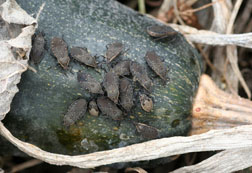
Figure 1. Squash bugs. |
Winter is spent in the adult stage under sheltering debris in the vicinity of previously infested plantings. Squash bugs become active in warm days during late spring and move to germinating squash. Mating and some feeding occur during this time followed by egg laying, which often begins around mid-June.
Squash bug eggs are very distinctive. They are shiny, slightly oval, and copper colored. Eggs are laid in small masses, most often on the underside of leaves. The first stage nymphs hatch in about a week and are pale green. Nymphs grow in stages, punctuated by molting, and then gradually increase in size. Late stage nymphs are grayish and possess dark wing pads. A final molt allows the adult stage to emerge. Mixtures of nymphs and adults may occur together in large masses. During periods of extreme warmth or cold they often hide around the base of the plant and move onto the plant when conditions are more favorable.
A second generation is then produced, with adults of this generation present in late summer and early fall. These adults then move to winter shelter and go dormant until the following spring. Nymphs that fail to develop to the adult stage do not survive following hard frosts.
Both nymphs and adults feed by sucking sap from plants. However, their manner of feeding, sometimes described as ‘lacerate and flush’ is quite destructive. Cells around the feeding site are destroyed and with multiple feeding punctures areas of the leaf or stems may collapse and no longer move water. This produces wilting, which may rapidly and frequently result in the death of the whole plant.
Squash bugs will also move to feed on fruit. Feeding injuries may result in sunken, dead areas that allow entry of rotting organisms that eventually destroy the fruit. Alternately they may cause corky spots to form on the fruit surface, detracting from appearance.
Hard, winter squashes including pumpkin are the most commonly damaged plants. Less commonly summer squashes are damaged. Related cucurbits, such as cucumber and melons, are rarely damaged by squash bug.
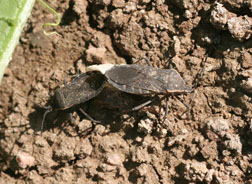
Figure 2. Mating pair of squash bugs. |
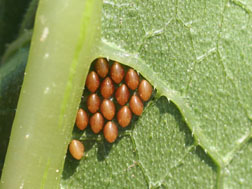
Figure 3. Squash bug eggs on the underside of a leaf. |
Squash Bug Control
Weather conditions appear to be very important in the severity of squash bug problems. Warm temperatures during the growing season allow most of the second generation nymphs to successfully reach the adult stage. Mild winter temperatures allow the overwintering adult bugs to survive from season to season.
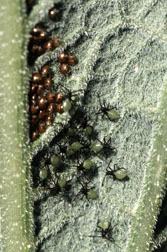
Figure 4. Early stage squash bugs at egg hatch. |
In small plantings, hand-picking can be very effective. Attention should be given to the eggs which are easily detected in garden surveys and can be crushed when detected. Egg surveys should be done at least once a week during June when egg laying is likely to begin.
Since squash bugs often seek shelter around the base of plants, this area should be cleared of debris. Mulches often provide protective cover for squash bugs and damage can be worse on plants that are mulched compared to those grown over bare soil.
The area around the base of the plant is also a site where insecticide applications should be concentrated. Diatomaceous earth/pyrethrins applications around the base of the plant can be an effective method to control squash bug and is a treatment allowed in Certified Organic vegetable production.
A few other insecticides, including those with esfenvalerate, permethrin, or carbaryl as the active ingredient, can also control squash bug. It is recommended that these treatments be applied early in the season. A first application should be made when eggs are first detected (i.e., June) followed by a second application a week or two later to provide excellent early season control on young plants. This early season management approach has several further advantages. For one, applications are made well before harvest, allowing insecticide residues to greatly degrade and diminish. Also, it reduces early population growth numbers that are available to lay eggs during the second generation later in the season.
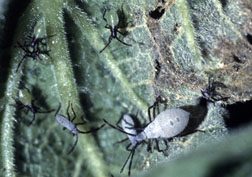
Figure 5. Late stage squash bug nymphs. |
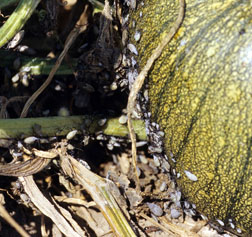
Figure 6. Squash bugs on pumpkin. |
*W. Cranshaw Colorado State University Extension entomology specialist, and professor, bioagricultural sciences and pest management. 4/08. Revised 1/13.
Colorado State University, U.S. Department of Agriculture, and Colorado counties cooperating. CSU Extension programs are available to all without discrimination. No endorsement of products mentioned is intended nor is criticism implied of products not mentioned.
Go to top of this page.





